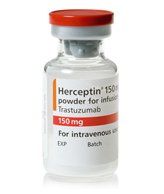AACR: Targeting Luminal Breast Cancer Stem Cells With Trastuzumab Blocks Metastatic Growth in Preclinical Models
Trastuzumab (Herceptin) therapy may be useful for the treatment of luminal breast cancer stem cells, preventing them from growing into macrometastases, according to preclinical results presented at the 2013 American Association for Cancer Research Annual Meeting.
Trastuzumab (Herceptin) therapy may be useful for the treatment of luminal breast cancer stem cells.

Washington, DC-Trastuzumab (Herceptin) therapy may be useful for the treatment of luminal breast cancer stem cells, preventing them from growing into macrometastases, according to preclinical results presented at the 2013 American Association for Cancer Research Annual Meeting, held April 6–10 in Washington, DC.
Luminal breast cancers are defined classically by their expression of estrogen and progesterone receptors and by their failure to overexpress the receptor tyrosine kinase HER2. In the clinic, however, the expression of HER2 is highly variable in luminal disease. Some patients with luminal breast cancer present as HER2-positive, while many others present as HER2-negative. Max Wicha, MD, of the University of Michigan Comprehensive Cancer Center, demonstrated in his presentation that in the original studies demonstrating the efficacy of trastuzumab, the first anti-HER2 therapy, a subsequent re-analysis of patient samples revealed a large number of false positives. Surprisingly, some patients who had incorrectly been classified as HER2-positive showed an even greater benefit from trastuzumab plus chemotherapy than patients with bona fide HER2-enriched disease.
Dr. Wicha’s lab was able to demonstrate how this benefit might be realized using cell culture. MCF7, one of the most commonly studied luminal breast cancer cell lines, is often used as a negative control for HER2 positivity, but in his experiments, expression of HER2 is actually heterogeneous, even in the same culture dish. Cells sorted for the cancer stem cell marker aldehyde dehydrogenase showed significant expression of HER2. “[HER2] is expressed selectively in the cancer stem cell population,” remarked Dr. Wicha. “[Cell growth assays] are just assaying the bulk population, not the stem cells.” If cancer stem cells in culture are tested for their ability to form spheres or express cancer stem cell markers, luminal cells demonstrate a clear need for HER2, since their growth could be suppressed by trastuzumab treatment. Of note, this cell sorting experiment could not be repeated in basal-like breast cancer cells, which are defined as expressing neither the hormone receptors nor HER2. This suggests that the reliance by cancer stem cells on HER2 is specific to luminal disease.
Luminal cancer stem cell regulation was revealed by a mouse experiment in which MCF7 cells were introduced into the bones to generate micrometastases. Dr. Wicha demonstrated that the metastatic environment presented a key driving force for the formation of cancer stem cells. In the bone, this was found to be RANK ligand, which stimulates the expression of HER2 in luminal cancer cells. If trastuzumab was given at the stage of micrometastasis, then the new lesions were unable to grow in mice; however, if he let the small metastases progress to macrometastasis, trastuzumab therapy no longer gave any benefit to the mice. “We think this explains why adjuvant [trastuzumab] treatments are so effective when HER2 is selectively expressed in the cancer stem cell.”
Finally, these results were corroborated using matched clinical samples. In collaboration with pathologists, HER2-positive and luminal breast cancer samples-which had been diagnosed HER2-negative-were collected. Importantly, the group was able to obtain matched primary tumor and metastatic samples. If samples were HER2-enriched in the primary tumor, the metastases were largely HER2-enriched as well. In the luminal samples, however, all primary samples showed no overexpression of HER2, whereas almost 90% of the bone metastases showed HER2 enrichment despite lack of gene amplification as assessed by fluorescence in situ hybridization. “What that is telling us is that HER2 is regulated in the microenvironment…tumor shrinkage and adjuvant therapies are two completely different models that depend on two different cell populations.” He noted the NSABP B-47 trial has recently begun to directly evaluate the benefit of trastuzumab in patients with a low expression of HER2 protein.
In all, Dr. Wicha’s presentation suggested that the paradigm by which we assess clinical efficacy-reduction of tumor burden-may not actually be translating into long-term survival, since the cancer stem cell population is not always targeted for cell death by the same agents that can induce death in the bulk tumor population. He is hopeful that efficacy will be demonstrated for the drug candidates that have moved into phase I clinical trials.
Newsletter
Stay up to date on recent advances in the multidisciplinary approach to cancer.